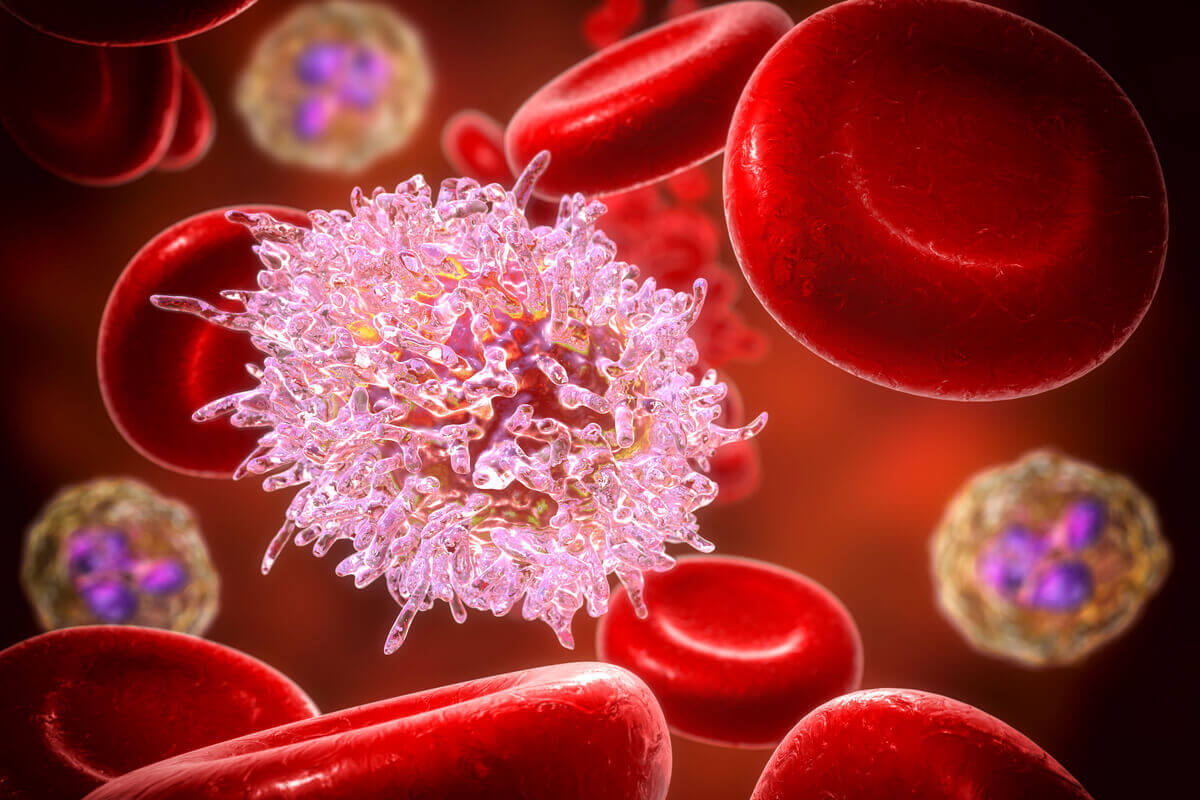Leukemia in Dogs: Causes and Symptoms

Leukemia in dogs is a type of cancer that fortunately isn’t too common. However, it’s important that you pay attention to your dog’s general health. This way, you’ll be able to identify and treat the disease quickly if it occurs.
Do you know what leukemia is? Do you know the causes and characteristic symptoms? Here we’ll give you answers to those questions and many more.
What is leukemia?
Leukemia is a type of cancer that causes an increase in white blood cells in the blood and bone marrow. There are two types in dogs: Lymphoid leukemia and myeloid leukemia.
Lymphoid leukemia is caused by cancer cells in the lymph nodes, which damage tissue and increase the number of white blood cells. On the other hand, myeloid leukemia is caused by the development of cancer cells in the bone marrow.
In general, experts consider acute myeloid leukemia to be the more dangerous of the two. However, you shouldn’t rule out the danger just because one of the types turns out to be chronic.
You should always keep in mind that the symptoms of leukemia in dogs can get worse. Without proper treatment, this disease can be fatal for your pet. Fortunately, there are clear signs that will allow you to act properly and in a timely manner.
If you identify symptoms of leukemia, consult your veterinarian immediately to establish a plan of action. Here are some of the causes, symptoms, and diagnosis of leukemia in dogs.

Causes of leukemia in dogs
Unfortunately, experts have yet to accurately determine the causes of leukemia in dogs. In most cases, veterinarians agree that it develops spontaneously. Thus, leukemia would be a cellular mutation in the osseous marrow.
Nevertheless, in spite of not being able to specify the precise causes, many veterinarians agree that some elements exist that predispose dogs to this disease. Some of the factors that could cause leukemia include exposure to radiation (including radio waves produced by household appliances).
Additionally, some viral diseases and exposure to toxic chemicals (including some cleaning products) can also be factors.
Because scientists have yet to pinpoint the causes of leukemia in dogs, it’s not entirely preventable. However, a balanced diet and exercise routine can largely prevent predisposition to its development.
Symptoms of leukemia in dogs
Symptoms will vary slightly depending on the type of leukemia affecting your pet. In addition, they’ll also depend on whether it’s chronic or acute. In the case of acute leukemia, the symptoms worsen quickly and require immediate treatment.
On the other hand, the symptoms of chronic leukemia are a little more difficult to identify at first. As the pathology extends over time, these signs develop very gradually.
Some dogs with chronic leukemia don’t present any symptoms at all. In these cases, the only way to discover the disease is through routine blood tests. For this reason, it’s very important that you take your pet for a routine check-up with your vet.
Leukemia usually affects adult or older pets, usually after the age of six. Some of the most common symptoms to watch for are
- Pale gums
- Whitish colored tongue
- Sudden loss of appetite or weight loss
- Weakness
- Fever
- Vomiting
- Excessive increase in thirst or sudden dehydration
- Irregular breathing or heartbeat
- Bruises or excessive bleeding from small wounds
- Constant infections
- Slow healing
- Changes of temper or aggression
Unfortunately, these symptoms are almost the same as those of many other types of conditions. For example, many types of cancer and autoimmune diseases. For a proper diagnosis, you should consult your veterinarian.

The diagnosis of leukemia in dogs
In many cases, the condition develops slowly and its external and evident symptoms don’t appear in the initial stages. Because of this, in most cases, leukemia is discovered through a routine blood test.
If your dog’s blood test shows a high number of white blood cells, your vet will probably perform more tests. These tests will determine if the white blood cells indicate infection, leukemia, or other conditions.
If you have them, you should provide your vet with the results of your dog’s previous blood tests. This will allow the professional to determine the animal’s “normal” levels prior to the illness.
In the event that your vet diagnoses your dog with leukemia, he or she will determine the best course of treatment. In general, most of the symptoms can be relieved. Although leukemia can never be completely cured, many dogs survive for years.
Leukemia in dogs is a type of cancer that fortunately isn’t too common. However, it’s important that you pay attention to your dog’s general health. This way, you’ll be able to identify and treat the disease quickly if it occurs.
Do you know what leukemia is? Do you know the causes and characteristic symptoms? Here we’ll give you answers to those questions and many more.
What is leukemia?
Leukemia is a type of cancer that causes an increase in white blood cells in the blood and bone marrow. There are two types in dogs: Lymphoid leukemia and myeloid leukemia.
Lymphoid leukemia is caused by cancer cells in the lymph nodes, which damage tissue and increase the number of white blood cells. On the other hand, myeloid leukemia is caused by the development of cancer cells in the bone marrow.
In general, experts consider acute myeloid leukemia to be the more dangerous of the two. However, you shouldn’t rule out the danger just because one of the types turns out to be chronic.
You should always keep in mind that the symptoms of leukemia in dogs can get worse. Without proper treatment, this disease can be fatal for your pet. Fortunately, there are clear signs that will allow you to act properly and in a timely manner.
If you identify symptoms of leukemia, consult your veterinarian immediately to establish a plan of action. Here are some of the causes, symptoms, and diagnosis of leukemia in dogs.

Causes of leukemia in dogs
Unfortunately, experts have yet to accurately determine the causes of leukemia in dogs. In most cases, veterinarians agree that it develops spontaneously. Thus, leukemia would be a cellular mutation in the osseous marrow.
Nevertheless, in spite of not being able to specify the precise causes, many veterinarians agree that some elements exist that predispose dogs to this disease. Some of the factors that could cause leukemia include exposure to radiation (including radio waves produced by household appliances).
Additionally, some viral diseases and exposure to toxic chemicals (including some cleaning products) can also be factors.
Because scientists have yet to pinpoint the causes of leukemia in dogs, it’s not entirely preventable. However, a balanced diet and exercise routine can largely prevent predisposition to its development.
Symptoms of leukemia in dogs
Symptoms will vary slightly depending on the type of leukemia affecting your pet. In addition, they’ll also depend on whether it’s chronic or acute. In the case of acute leukemia, the symptoms worsen quickly and require immediate treatment.
On the other hand, the symptoms of chronic leukemia are a little more difficult to identify at first. As the pathology extends over time, these signs develop very gradually.
Some dogs with chronic leukemia don’t present any symptoms at all. In these cases, the only way to discover the disease is through routine blood tests. For this reason, it’s very important that you take your pet for a routine check-up with your vet.
Leukemia usually affects adult or older pets, usually after the age of six. Some of the most common symptoms to watch for are
- Pale gums
- Whitish colored tongue
- Sudden loss of appetite or weight loss
- Weakness
- Fever
- Vomiting
- Excessive increase in thirst or sudden dehydration
- Irregular breathing or heartbeat
- Bruises or excessive bleeding from small wounds
- Constant infections
- Slow healing
- Changes of temper or aggression
Unfortunately, these symptoms are almost the same as those of many other types of conditions. For example, many types of cancer and autoimmune diseases. For a proper diagnosis, you should consult your veterinarian.

The diagnosis of leukemia in dogs
In many cases, the condition develops slowly and its external and evident symptoms don’t appear in the initial stages. Because of this, in most cases, leukemia is discovered through a routine blood test.
If your dog’s blood test shows a high number of white blood cells, your vet will probably perform more tests. These tests will determine if the white blood cells indicate infection, leukemia, or other conditions.
If you have them, you should provide your vet with the results of your dog’s previous blood tests. This will allow the professional to determine the animal’s “normal” levels prior to the illness.
In the event that your vet diagnoses your dog with leukemia, he or she will determine the best course of treatment. In general, most of the symptoms can be relieved. Although leukemia can never be completely cured, many dogs survive for years.
All cited sources were thoroughly reviewed by our team to ensure their quality, reliability, currency, and validity. The bibliography of this article was considered reliable and of academic or scientific accuracy.
- Fabián, A., Carmen, M., & Gasccón, M. (2001). Las alteraciones de la médula ósea en el perro y el gato. Clínica veterinaria de pequeños animales, 21(3), 0232-249.
- Flores, E. (1986). Epidemiología del cáncer en perro y gato. Monografias de Medicina Veterinaria, 8(2).
- Martínez, E. M., Fragío, C., & Díez Bru, N. (1995). Leucemia linfocítica crónica y su respuesta al tratamiento en un perro. Clínica veterinaria de pequeños animales, 15(4), 0217-220.
This text is provided for informational purposes only and does not replace consultation with a professional. If in doubt, consult your specialist.








